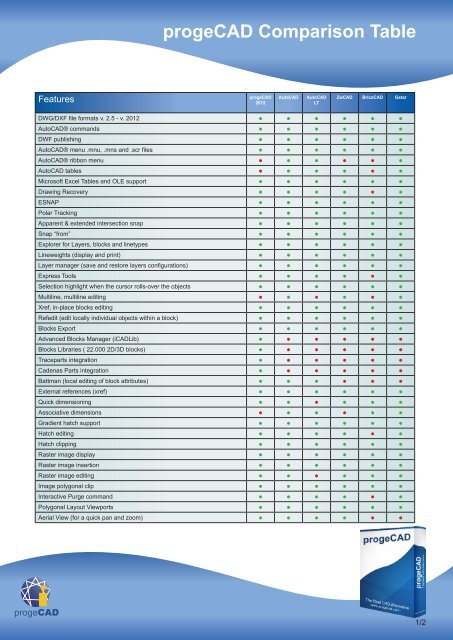

#PROGECAD BLOCK EDIT FULL#
Each record must be followed by a full DOS carriage return, including the final record (so, no blank lines in between records - but a final blank line with no spaces in it). It is also reported that these templates have a couple of obscure rules when used in AutoCAD.

A faulty template file will result in 0 records extracted. NOTE: Creating old ATTEXT templates is evidently a bit tricky. So, to export, say, block numbers, block names, our material attribute, our cost attribute and lastly our supplier attribute for the drawing of triangle blocks used above we would write this actual template file in notepad and save as, say, "mytemplate.txt": Which means "character field, maximum length 60, no decimal places" character fields have no decimals see below.for records in the format of:įor example, to export the "DEMO-MATERIAL" attribute from our example above we would add the following record pair to our template file: 'N' literal 'N' indicating numeric fields and this syntax is used to extract custom attribute data 'C' literal 'C' indicating character format -or. Here is a list of standard attributes:īL:LEVEL NFFF000 (Block nesting level) BL:NAME CFFF000 (Block name) BL:X NFFFPPP (X coordinate of block insertion point) BL:Y NFFFPPP (Y coordinate) BL:Z NFFFPPP (Z coordinate) BL:NUMBER NFFF000 (Block counter same for MINSERT) BL:HANDLE CFFF000 (Block handle same for MINSERT) BL:LAYER CFFF000 (Block insertion layer name) BL:ORIENT NFFFPPP (Block rotation angle) BL:XSCALE NFFFPPP (X scale factor) BL:YSCALE NFFFPPP (Y scale factor) BL:ZSCALE NFFFPPP (Z scale factor) BL:XEXTRUDE NFFFPPP (X component of block extrusion direction) BL:YEXTRUDE NFFFPPP (Y component) BL:ZEXTRUDE NFFFPPP (Z component) According to progeCAD documentation, the format for this template file is ASCII text series of single line records made of name-format pairs. Each record pair specifies a single attribute to be exported, in the order you wish the attributes to be exported. Using this command allows you to export entity attributes using a pre-defined template file which must be created first. Note that ATTEXT will only recognize block attributes if they were defined BEFORE the block was inserted into the drawing. In progeCAD 2016, internal blocks can be made "annotative" so that they scale automatically according to the annotation scale of the viewport. Custom attribute information can be inserted using the ATTDEF command while in the block's "local editing" workspace. A block's custom attributes can be viewed and edited using the BATTMAN command (for ATTEXT they need to be checked with DDATTE - see reason below).Īnother way to generate a basic BOM in progeCAD is using the older ATTEXT command (menu "Tools -> Extract Attributes."). Blocks also offer a great way to represent design components that we want reflected later in a bill of materials. Changes to the block will be reflected everywhere it is used in the drawing. And if we have a 3D block of the fastener, we can also re-use that block again in all of different views of our drawing. Rather than actually drawing the same fastener detail from scratch every time it is needed in a view, our fastener block can be inserted as a reference entity everywhere we want the fastener to appear, saving both data space and drawing time. For example, say we use the same fastener several times in a drawing. Blocks are drawings which can be re-used multiple times in another larger drawing. To begin with, both progeCAD and AutoCAD support the use of external and internal blocks in a drawing file. These programs are potentially suitable for any of those specific domains when given little extra thought from the user. AutoCAD or progeCAD, on the other hand, are seen as more general-use design standards. Most BOMs are expected to report intelligence about materials, suppliers, part numbers and other attributes of a design's components in a way that is already specific to a certain domain, such as building or machine design or electronics, etc. Wikipedia defined a Bill Of Materials, BOM or product structure as "a list of the raw materials, sub-assemblies, intermediate assemblies, sub-components, parts and the quantities of each needed to manufacture an end product".


 0 kommentar(er)
0 kommentar(er)
